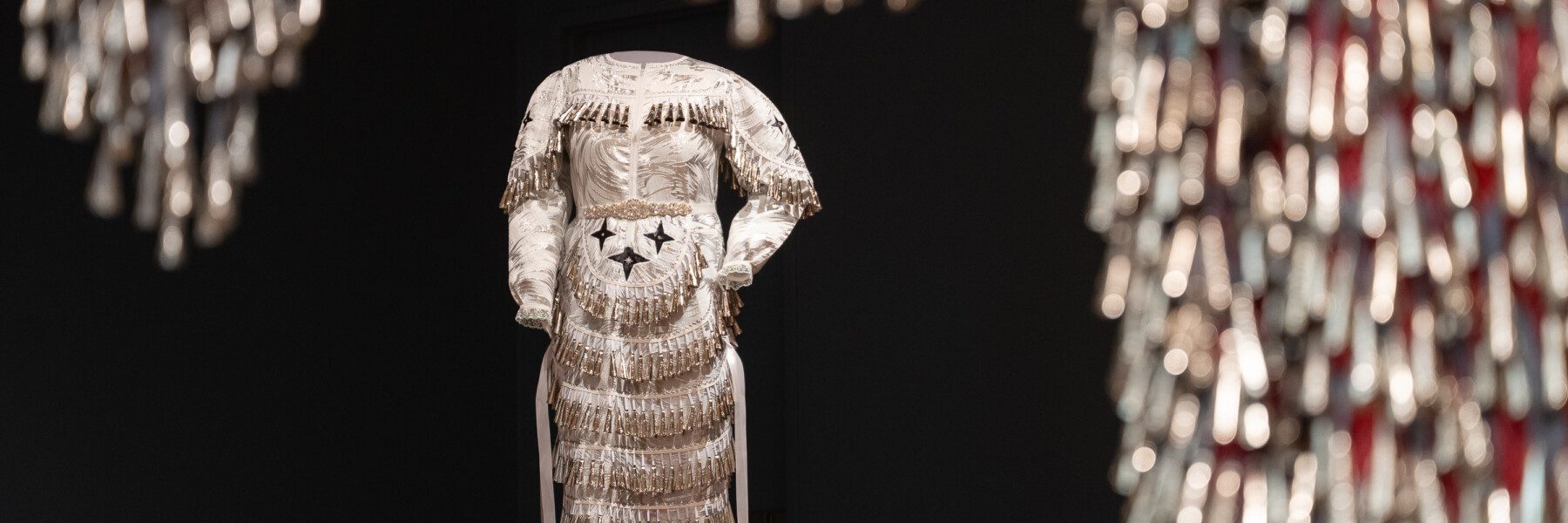SHELBURNE, Vt. – [July 1, 2025] – A new exhibition at Shelburne Museum showcases the works of five Native American artists who incorporate sound in paintings, three-dimensional works and textiles. Making a Noise: Indigenous Sound Art is the latest in the museum’s series of exhibitions focusing on Native American art.
On view through October 26, Making a Noise features five contemporary artists who draw on historic forms to create complex, culturally pressing works that speak to a history of healing and resistance. Many of these works are interactive, using sound to engage visitors to in their layered meanings.
“The artists in Making a Noise create works that invoke historic methods and materials, yet are cutting-edge cultural expressions of today,” said Victoria Sunnergren, Associate Curator of Native American Art.
Featured artists are: Aerius Benton-Banai (Lac Courte Oreilles Ojibwe Tribe), Chelsea Bighorn (Lakota, Dakota, and Shoshone-Paiute), Nanibah Chacon (Diné and Xicana), Kite (Oglála Lakȟóta), and Marie Watt (Seneca Nation of Indians [Turtle Clan] and German-Scot Ancestry).
Benton-Banai, Bighorn and Watt use ziibaaska’iganan, or jingle cones, in their artworks. These cones, made of rolled pieces of metal, are usually found on powwow dresses such as Winter Storm Jingle Dress and Belt by Benton-Banai on view in the exhibition. For half of the 20th century ceremonial dancing was banned by the federal government. At great personal risk, Indigenous dressmakers and dancers spread the jingle dress dance despite the ban. They kept the practice alive until the passage of the American Indian Religious Freedom Act gave official protection to ceremonial dances in 1978. Today, the dance continues to serve as a powerful symbol of resilience.
In Watt’s artwork, large masses of jingle cones hang from the gallery ceiling like clouds. The artwork evokes powwow dances even though there is no dress or music. In this way, Watt expands the healing power of the jingle cones to new audiences.
“Simultaneously heavy and weightless, the jingles nudge and tap each other, creating murmurs of sound when animated by a breeze. They amplify each other’s stories, reverberating with each passing movement,” Watt said.
Bighorn also uses jingle cones, incorporating them into tapestries and chainmail. For one work in the exhibition, she hand built hundreds of jingle cones from soda cans.
Kite translates dreams and musical compositions into stone structures and embroidered hides. Her work draws on the visual language used in Lakȟóta beadwork. Her work “From Elsewhere” speaks back to the museum visitor, recognizing and responding to approaching faces.
Chacon works with Lucas Gonzalez (Bogotá, Colombia) to create a work integrating Diné textile motifs, abstract line work and sound capabilities incorporating guitar pickups and music wire that produce noise in response to touch. This work builds on Chacon’s previous “wall weavings,” murals made of string that use some of the same shapes as Diné textiles. Working with Gonzalez, she created her first playable wall weaving, made of music wire.
Making a Noise opened just as construction commenced on a new building on Shelburne Museum’s campus devoted to the stewardship and exhibition of Indigenous art.
When opened in 2027, the Perry Center for Native American Art will serve as a welcoming space for Tribal members and scholars to study and engage with the museum’s collection of more than 500 items from 389 Tribal Nations across the continent.
For more information, please visit www.shelburnemuseum.org.
High-resolution images are available for download HERE.
A PDF version of the Press Release is available for download HERE.
Image: Winter Storm Jingle Dress and Belt, by Aerius (Jingogiizhigookwe) Benton-Banai (Lac Courte Oreilles Ojibwe Tribe) is framed by works in the foreground by Marie Watt (Seneca Nation of Indians [Turtle Clan] and German-Scot Ancestry) Sky Dances Light: Forest IV, Forest V, Forest VI (detail). Both artists are featured in Making a Noise: Indigeous Sound Art at Shelburne Museum on view through October 26, 2025.
About Shelburne Museum
Founded in 1947 by trailblazing folk art collector Electra Havemeyer Webb (1888–1960), Shelburne Museum in Shelburne, Vermont, is the largest art and history museum in northern New England and Vermont’s foremost public resource for visual art and material culture. The Museum’s 45-acre campus is comprised of 39 buildings including the Pizzagalli Center for Art and Education and Webb Gallery featuring important American paintings by Andrew Wyeth, Winslow Homer, Anna Mary Robertson “Grandma” Moses, John Singleton Copley and many more. Construction is underway for the Perry Center for Native American Art, designed in partnership with Indigenous voices and devoted to the stewardship and exhibition of the Native American art in the museum’s care, scheduled to open in 2027. For more information, please visit shelburnemuseum.org.
For media inquiries, please contact:
Leslie Wright
Director of Marketing and Communications
Shelburne Museum
lwright@shelburnemuseum.org
802-985-0880
Kristen Levesque
Kristen Levesque Public Relations
kristen@kristenlevesquepr.com
207-329-3090

